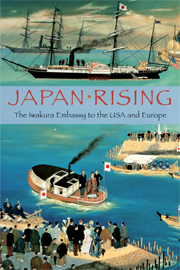Book contents
- Frontmatter
- Contents
- Introduction by Ian Nish
- Note on the Text
- VOLUME I THE UNITED STATES OF AMERICA
- VOLUME II BRITAIN
- VOLUME III CONTINENTAL EUROPE, 1
- 41 A Survey of France
- 42 A Record of Paris, 1
- 43 A Record of Paris, 2
- 44 A Record of Paris, 3
- 45 A Record of Paris, 4
- 46 A Record of Paris, 5
- 47 A Record of Paris, 6
- 48 A Record of Paris, 7
- 49 A Survey of Belgium
- 50 A Record of Belgium, 1
- 51 A Record of Belgium, 2
- 52 A Survey of Holland
- 53 A Record of the Hague, Rotterdam and Leiden
- 54 A Record of Amsterdam
- 55 A Survey of Prussia
- 56 The Journey by Rail Through Western Prussia
- 57 A Survey of Berlin
- 58 A Record of Berlin, 1
- 59 A Record of Berlin, 2
- 60 A Record of Berlin, 3; with a Supplement on Potsdam
- VOLUME IV CONTINENTAL EUROPE, 2
- VOLUME V CONTINENTAL EUROPE, 3; AND THE VOYAGE HOME
- Index
54 - A Record of Amsterdam
Published online by Cambridge University Press: 04 August 2010
- Frontmatter
- Contents
- Introduction by Ian Nish
- Note on the Text
- VOLUME I THE UNITED STATES OF AMERICA
- VOLUME II BRITAIN
- VOLUME III CONTINENTAL EUROPE, 1
- 41 A Survey of France
- 42 A Record of Paris, 1
- 43 A Record of Paris, 2
- 44 A Record of Paris, 3
- 45 A Record of Paris, 4
- 46 A Record of Paris, 5
- 47 A Record of Paris, 6
- 48 A Record of Paris, 7
- 49 A Survey of Belgium
- 50 A Record of Belgium, 1
- 51 A Record of Belgium, 2
- 52 A Survey of Holland
- 53 A Record of the Hague, Rotterdam and Leiden
- 54 A Record of Amsterdam
- 55 A Survey of Prussia
- 56 The Journey by Rail Through Western Prussia
- 57 A Survey of Berlin
- 58 A Record of Berlin, 1
- 59 A Record of Berlin, 2
- 60 A Record of Berlin, 3; with a Supplement on Potsdam
- VOLUME IV CONTINENTAL EUROPE, 2
- VOLUME V CONTINENTAL EUROPE, 3; AND THE VOYAGE HOME
- Index
Summary
March 2nd, 1873. Cloudy.
At a quarter past ten we boarded our train with our escorts and set out for Amsterdam. The landscape on the way was entirely flat and intersected by canals with dikes on either side planted with willow-trees. These trees grow easily, so they are planted in copses of short trees and pollarded each year, providing an indispensable product for military purposes since the charcoal made from their branches is ideal for the manufacture of gunpowder.
Situated on the shores of the Zuider Zee, Amsterdam is the capital of North Holland province and the pre-eminent city in the country. There was a time when it was also the royal capital, but now it serves as a crucial centre of commerce within Europe. Trade in this port is such that invariably a hundred ships will come in with each tide, and on occasion up to double that, and there is never a day when one finds fewer than six hundred ships moored in the harbour. The oysters cultivated in the sea here are the best in all Europe and command a high price. Europeans have a passion for oysters, which has proved very beneficial to the Dutch, and these shellfish can also be found in abundance along the coast off New York. It was due to their experience in turning a profit from this trade that the Dutch used to come to Nagasaki to purchase and export oysters from Hizen.
- Type
- Chapter
- Information
- Japan RisingThe Iwakura Embassy to the USA and Europe, pp. 282 - 286Publisher: Cambridge University PressPrint publication year: 2009



